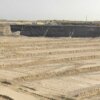Bearing capacity of a foundation is the maximum load that can be applied on a foundation, before failure or uncontrolled deformations occur.
To be clear, there is no one “bearing capacity” for fill. The bearing capacity of a shallow foundation constructed on or in the fill can be defined by examining specific parameters:
- the dimensions of the foundation;
- the foundation depth;
- the thickness and shear strength of the fill layer;
- the natural foundation soil, if present within the zone of influence of the foundation; and
- the groundwater table.
Checking the ground bearing capacity for a shallow foundation or a stack of containers can easily be done and will seldom lead to bearing capacity problems, provided the fill layer thickness is large enough to prevent punch trough or other type of failure modes.
For temporary conditions during construction, the fresh fill material must be able to support construction plant and equipment. Wet cohesive soils particularly are prone to rapid softening and therefore may not be able to support wheeled or tracked vehicles, that is, the site easily becomes a quagmire. Checking the trafficability of the fresh fill is essential.
The bearing capacity may become an issue when the subsoil consists of cohesive fine-grained material.
In principle the peak shear undrained strength can be used; although the geotechnical engineer needs to use his ‘engineering judgement’ to decide when using the remoulded undrained shear strength would be more appropriate. This could occur when the soil becomes heavily disturbed by the operations or the traffic.
Zone load testing
A direct method to verify the bearing capacity in the field is the execution of a Zone Load Test (ZLT) which, in fact, is a large Plate Load Test (PLT). In such a test, a footing with more realistic dimensions (for instance, a 3 meter by 3 meter plate) is loaded up to its design load or more while the settlement behaviour is monitored.
The actual safety factor with respect to the Ultimate Limit State can be verified by means of extended load procedures. The prediction of the long-term behaviour by extrapolating the settlement measured during a 24 hour or even 48 hour time interval is also be possible.
When Zone Load Tests are used, the specifications often require that the settlement under the design load has to be limited to a certain long-term settlement (for example, 25 mm). This is, in fact, an indirect specification for the bearing capacity since the limited settlement can only be guaranteed when the bearing capacity is fulfilled. In this case no factor of safety for the bearing capacity is specified.
Models for safety factors
In the case of selecting a safety factor, the allowed deformations are indirectly defined. A smaller safety factor results, in principle, in larger deformations. An overall larger safety factor against loss of bearing capacity will generally result in a design where deformations remain limited within commonly accepted allowable values. However, when deformations are less important, a smaller safety factor might be acceptable.
Models known as Finite Element Methods are used to check bearing capacity but even then, it is difficult to define the maximum load that can be applied on a foundation with given dimensions. Basically the Finite Element Methods is a method in which the stress-strain behaviour of the soil is modelled as realistically as possible. However, failure occurs if deformations become uncontrollable and this cannot be modelled with standard Finite Element Methods software.
In general, the dimensions and foundation level are chosen and the design load is applied. The factor of safety is then calculated until the deformations become unrealistically large because of the instability of the system.
Alternatively, the load on a foundation may be increased until failure occurs, while using the actual design shear strength characteristics for the soil layers in the model.
Such a failure analysis using Finite Element Methods requires some further attention since, according to the applicable Standards, different load factors apply for permanent and live loads respectively.


















